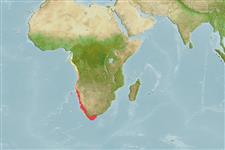Common names from other countries
>
Carangiformes (Jacks) >
Carangidae (Jacks and pompanos) > Caranginae
Etymology: Trachurus: Greek, trachys, -eia, -ys = rough + Greek, oura = tail (Ref. 45335).
More on author: Castelnau.
Environment: milieu / climate zone / depth range / distribution range
Ecologia
marino; distribuzione batimetrica 0 - 500 m (Ref. 54925), usually 100 - 300 m (Ref. 54925). Subtropical; 7°N - 37°S, 4°E - 24°E (Ref. 54925)
Eastern Atlantic: Gulf of Guinea to South Africa. Bianchi et. al. 1993 notes 'Smith-Vaniz (1992, pers. comm.) does not believe that Trachurus capensis is a valid species but admits that an adequate series of this species along the coast of Africa are not available'.
Length at first maturity / Size / Peso / Age
Maturity: Lm 32.5, range 20 - 33 cm
Max length : 60.0 cm FL maschio/sesso non determinato; (Ref. 3166); common length : 30.0 cm FL maschio/sesso non determinato; (Ref. 3166)
Adults are found mainly over the continental shelf, often over sand bottoms (Ref. 27121). Shoals rise to feed in surface waters at night and found close to the bottom during the day (Ref. 27121). Juveniles feed mainly on copepods while adults prey on fish and a wide range of invertebrates (Ref. 27121).
Smith-Vaniz, W.F., J.-C. Quéro and M. Desoutter, 1990. Carangidae. p. 729-755. In J.C. Quero, J.C. Hureau, C. Karrer, A. Post and L. Saldanha (eds.) Check-list of the fishes of the eastern tropical Atlantic (CLOFETA). JNICT, Lisbon; SEI, Paris; and UNESCO, Paris. Vol. 2. (Ref. 7097)
IUCN Red List Status (Ref. 130435)
CITES (Ref. 128078)
Not Evaluated
Threat to humans
Harmless
Human uses
Pesca: elevato interesse commerciale
Strumenti
Warning: mysqli::__construct(): (HY000/1040): Too many connections in /var/www/html/includes/speciessummary.lib.php on line 2104
Can't connect to MySQL database fbquizv2. Errorcode: Too many connections
